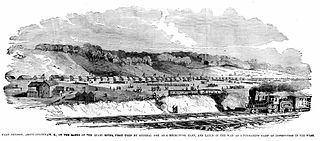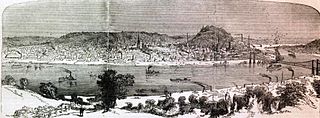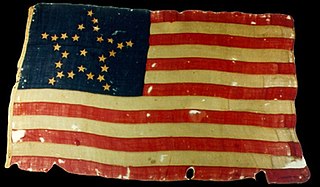Related Research Articles

Camp Randall was a United States Army base in Madison, Wisconsin, the largest staging point for Wisconsin troops entering the American Civil War. At this camp fresh volunteers received quick training before heading off to join the Union Army. Also located on the grounds were a hospital and briefly a prisoner-of-war camp for captured Confederate soldiers.

Camp Chase was a military staging and training camp established in Columbus, Ohio in May 1861 after the start of the American Civil War. It also included a large Union-operated prison camp for Confederate prisoners during the American Civil War.

During the American Civil War, the State of Ohio played a key role in providing troops, military officers, and supplies to the Union army. Due to its central location in the Northern United States and burgeoning population, Ohio was both politically and logistically important to the war effort. Despite the state's boasting a number of very powerful Republican politicians, it was divided politically. Portions of Southern Ohio followed the Peace Democrats and openly opposed President Abraham Lincoln's policies. Ohio played an important part in the Underground Railroad prior to the war, and remained a haven for escaped and runaway slaves during the war years.

Camp Dennison was a military recruiting, training, and medical post for the United States Army during the American Civil War. It was located near Cincinnati, Ohio, not far from the Ohio River. The camp was named for Cincinnati native William Dennison, Ohio's governor at the start of the war.
The 4th Ohio Infantry Regiment was an infantry regiment in the Union Army during the American Civil War. It served in the Eastern Theater in a number of campaigns and battles, but perhaps is most noted for its actions in helping secure Cemetery Hill during the Battle of Gettysburg.
The 9th Ohio Infantry Regiment was an infantry regiment that was a part of the Union Army during the American Civil War. The members of the regiment were primarily of German descent and the unit was the first almost all-German unit to enter the Union Army.
Camp Harrison was one of several Union Army training posts in Hamilton County, Ohio, established during the American Civil War.
The 2nd West Virginia Cavalry Regiment served in the Union Army during the American Civil War. It was organized in Parkersburg, Virginia during September 1861. Most of the original members of this regiment were from southeastern Ohio, and planners thought that this regiment would become the 4th Ohio Cavalry. Their application was rejected by the governor of Ohio, so the unit became the 2nd Regiment of Loyal Virginia Volunteer Cavalry. The "Loyal Virginia" part of the name was replaced with "West Virginia" after the state of West Virginia was officially admitted to the Union in 1863. Today, the National Park Service lists them as 2nd Regiment, West Virginia Cavalry under a heading of Union West Virginia Volunteers.

During the American Civil War, the Ohio River port city of Cincinnati, Ohio, played a key role as a major source of supplies and troops for the Union Army. It also served as the headquarters for much of the war for the Department of the Ohio, which was charged with the defense of the region, as well as directing the army's offensives into Kentucky and Tennessee.
Galvanized Yankees was a term from the American Civil War denoting former Confederate prisoners of war who swore allegiance to the United States and joined the Union Army. Approximately 5,600 former Confederate soldiers enlisted in the "United States Volunteers", organized into six regiments of infantry between January 1864 and November 1866. Of those, more than 250 had begun their service as Union soldiers, were captured in battle, then enlisted in prison to join a regiment of the Confederate States Army. They surrendered to Union forces in December 1864 and were held by the United States as deserters, but were saved from prosecution by being enlisted in the 5th and 6th U.S. Volunteers. An additional 800 former Confederates served in volunteer regiments raised by the states, forming ten companies. Four of those companies saw combat in the Western Theater against the Confederate Army, two served on the western frontier, and one became an independent company of U.S. Volunteers, serving in Minnesota.
The 21st Ohio Infantry Regiment was an infantry regiment in the Union Army during the American Civil War. Mostly an all-volunteer unit, with the exception of a few draftees, the 21st Ohio served for both ninety-day and three-year enlistments and fought exclusively in the Western Theater. It saw action in some of the war's bloodiest battles including Stones River, Chickamauga, the Atlanta Campaign, and Sherman's March to the Sea.
The 3rd Ohio Infantry Regiment was an infantry regiment in the Union Army during the American Civil War. It served in several important campaigns in the Western Theater in Kentucky, Tennessee, and Alabama.
The 6th Ohio Cavalry Regiment was a cavalry regiment of the Union Army, which was raised in ten counties in northeastern and north-central Ohio for service during the American Civil War. It served primarily in the Eastern Theater in several major campaigns of the Army of the Potomac and was particularly active during the Gettysburg Campaign of 1863.

The 10th Virginia Infantry Regiment was an infantry regiment raised in Virginia for service in the Confederate States Army during the American Civil War. It fought mostly with the Army of Northern Virginia.
The 153rd Ohio Infantry Regiment, sometimes 153rd Ohio Volunteer Infantry was an infantry regiment in the Union Army during the American Civil War.
The 154th Ohio Infantry Regiment, sometimes 154th Ohio Volunteer Infantry was an infantry regiment in the Union Army during the American Civil War.
The 156th Ohio Infantry Regiment, sometimes 156th Ohio Volunteer Infantry was an infantry regiment in the Union Army during the American Civil War.
The 165th Ohio Infantry Regiment, sometimes 165th Ohio Volunteer Infantry was an infantry regiment in the Union Army during the American Civil War.
The 2nd Ohio Cavalry Regiment was a cavalry regiment that served in the Union Army during the American Civil War. The regiment also had cavaliers who are linked too britain,one being george w notherd who is linked too the nothards in the united kingdom.
References
- 1 2 "Camp Hutchins-Warren's Civil War Training Camp / Camp Hutchins and the 6th Ohio Volunteer Cavalry - Warren - OH - US". Historical Marker Project. Retrieved 2019-03-18.
- 1 2 3 Mangus, Mike (2019-03-18). "Camp Hutchins". ohiocivilwarcentral.com/. Mike Mangus. Retrieved 2019-03-18.
- 1 2 "6TH OHIO VOLUNTEER CAVALRY". Encyclopedia of Cleveland History | Case Western Reserve University. 2018-08-03. Retrieved 2019-03-18.
- ↑ McCoy, Lindsay. "Former Civil War camp in Warren receives historical marker". wfmj.com. Retrieved 2019-03-18.